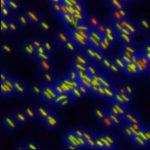Link to Pubmed [PMID] – 25779320
Methods Mol. Biol. 2015;1285:241-56
The crucial role of phenotypic heterogeneity in bacterial physiology and adaptive responses has required the introduction of new ways to investigate bacterial individuality. Time-lapse microscopy is a powerful technique for evaluating phenotypic diversity in bacteria at the single-cell level, whether exploring the dynamics of gene expression and protein localization or characterizing the heterogeneous phenotypic response to perturbations. Here, we present protocols to carry out time-lapse imaging of mycobacteria at the single-cell level using either agarose pads or customized microfluidic devices. The sequences of images obtained can be analyzed using programs such as ImageJ and allow the investigator not only to extract various parameters of growth and gene expression dynamics but also to unravel the physiological basis behind phenomenon such as persistence against stresses.

